During the recent South Australian Wooden Boat Festival (pic of three of our five ozracers on the beach right) there was so much wind that many events were cancelled, but Michael Storer had a crack at the speed record for PDRacers in the OzRacer. The previous record was 6.3mph – we raised it to 9.1.
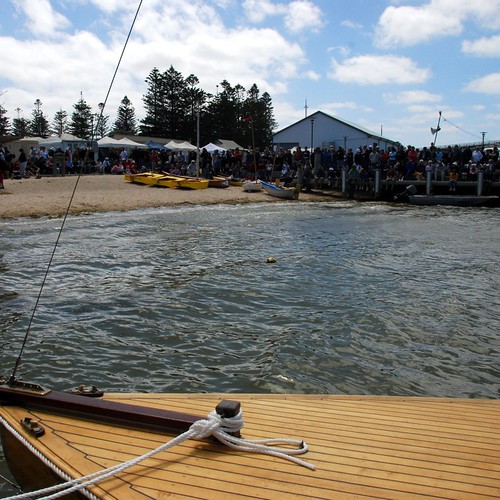
Actually we briefly thought he cracked 14.2 knots and we got a bit excited till we realised that Michael was waving the gps in his arms celebrating the 8!
8ft OzRacer Plan Information – good to store and carries one person plus another not too heavy
12ft Oz Goose Plan information – faster, carries three people easily
Why does the OzRacer Sail so well?
Even though the PDRacer is a humble, simple boat the OZ version was worked over to have a lightweight hull that is hugely strong but still very easy to build, good accurate rudder and centreboard shapes and lots of sail on a bendy mast. All of this in a very detailed plan for $40.
The other side of the record attempt was not only the big apparent increase in speed over other boats in the duck type but just how easy it was to handle the big sail – the PDR carries more sail than a Laser – but a Laser would have been a real struggle to hold up in the conditions. See Michael’s report below for more detail in that area.
We’ve got a big weekend coming up with Mik and the boats in Brisbane at the Timber and Working with Wood Show, should get another 100,000 or so visitors!
The story of breaking the PDRacer speed record in an OzRacer by the pilot.
Here is Mik’s take on the day.
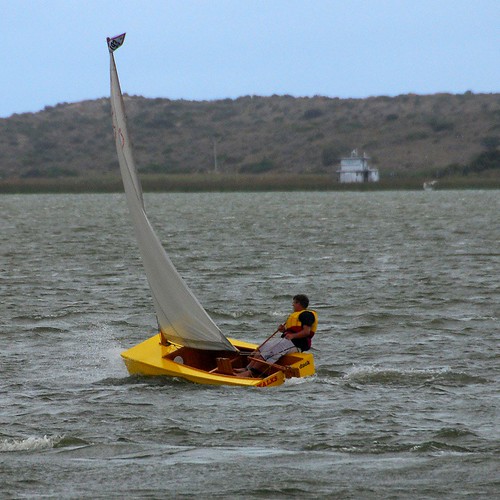 I was hoping to run away with the Australian National PDRacer titles and was a bit relieved to not have to face the actual test of racing the others because of quite a bit too much wind. Three of the boats were to be launched for the first time and the various owners were not keen on debugging the boats in 20 to 25 knots of breeze and a big chop (as you can see from the photos).
I was hoping to run away with the Australian National PDRacer titles and was a bit relieved to not have to face the actual test of racing the others because of quite a bit too much wind. Three of the boats were to be launched for the first time and the various owners were not keen on debugging the boats in 20 to 25 knots of breeze and a big chop (as you can see from the photos).
Despite the big show and large number of boats attending you can see there were no other boats out at the time despite a number of planned events – it was just a bit too windy for most.
But it was important to fly the flag in front of all those people. So I decided to have a crack at the PDRacer world speed record. I had to beat 6.5 mph – a record held by Tim Cleary
I attached a GPS belonging to Rob Badenoch near the top of the centrecase – an area that wouldn’t get wet if I went over.
It was a little tight getting out of the corral formed by the beach and a wharf each side – particularly considering that the river was shallow because of the drought and I kept hitting rocks on the bottom as well.
The good side of the river being so low was that there was no current in any direction whatsoever – there hasn’t been any flow out of the Murray for a couple of years – so any speed measurements were not assisted in any way.
Handling the big wind and waves on the Chop Prone Goolwa waters
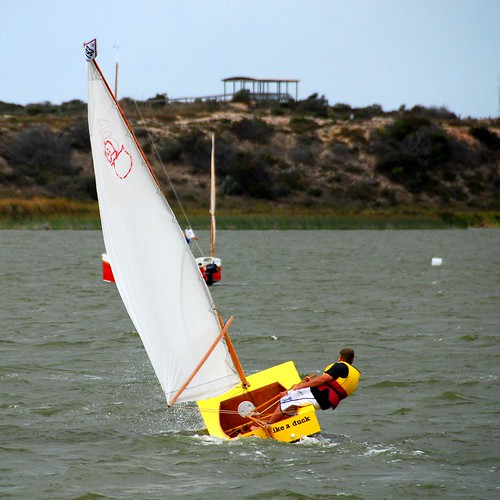 So I squeezed out between the two wharves and headed out into the river. First I sailed a bit upwind. The big centreboard and rudder giving good control – the boat felt very handleable and with a bit of a heel to leeward it climbed up over the chop with little trouble.
So I squeezed out between the two wharves and headed out into the river. First I sailed a bit upwind. The big centreboard and rudder giving good control – the boat felt very handleable and with a bit of a heel to leeward it climbed up over the chop with little trouble.
The extra speed and power in the sail did mean that I had to sit a lot further back to prevent the nose from digging in. Because of the curve of the PDR bottom – if you are a little too far forward the bow digs in as a gust hits and the boat gets bogged in its own bow-wave. But if you move just the right amount back the bow will lift up into the air as the gusts hit and the boat accelerates.
So to downwind sailing where the speed attempt would be made. I couldn’t actually see what the GPS was reading through all this – I was more interested in keeping the boat upright and intact in front of the crowd of probably 3 or 4 thousand at the wooden boatshow.
Bearing away and easing sails I quickly found what the more experienced American sailors had told us about – that you had to move a REALLY LONG WAY BACK to stop the bow digging in. Even if it did dig in there was plenty of buoyancy and water never came over the top of the bow to fill the cockpit – actually almost no water got aboard in the half hour I was out there and control was good because of our deep and large area rudder.
Bow rises at speed and drop if you go slow – solution – go fast!
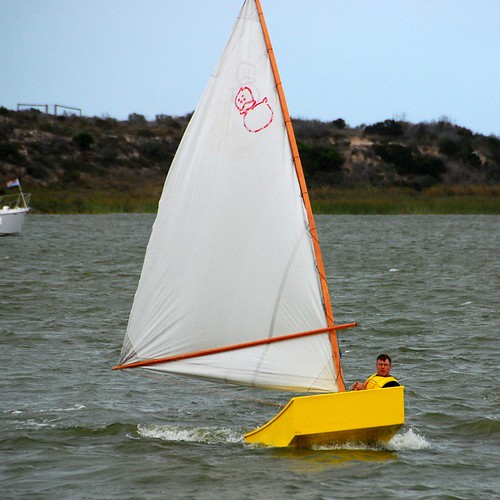 So moving back a lot more, the bow popped up to a crazy angle as the boat accelerated down the face of the first wave as a gust hit – this was not half hearted planing like in the video on the website – this was the proper thing. It felt much like any other boat on the plane – looser but still with good directional control.
So moving back a lot more, the bow popped up to a crazy angle as the boat accelerated down the face of the first wave as a gust hit – this was not half hearted planing like in the video on the website – this was the proper thing. It felt much like any other boat on the plane – looser but still with good directional control.
The picture right shows both the point of sail and the trim for the speed runs. I wasn’t able to see the GPS while sailing – but I think the fastest run was one of the first when I was heading in the opposite direction from this. A couple of nice waves and a big gust coinciding.
A funny thing happens when the gust finishes. With a boat this short with such a wide stern and lots of rocker it just goes back to normal displacement sailing – the V8 suddenly turns into a ride-on mower – most boats have a transition as they decelerate – but the PDR just jumps suddenly from one mode to another – it feels like 4 knots or .
Was it faster than the similar PDRacer record.
This was fun.
But was it faster than 6.2 knots? I did a couple more reaches backwards and forwards – tacking the boat was quick and easy – the large rudder doing its job – a few more waves and gust and accelerates and decelerates.
It was certainly a lot faster than I had been on the Mooloola river in front of Peter’s house.
So either it was enough to beat the record or it wasn’t.
So change of plan – the big test for a decent sailing boat is always whether it will go upwind in a decent wind and sea.
So I headed upwind toward the south into the eye of the wind. No problems at all – at least for someone with a background in small boat racing. The only thing is to sit back far enough so that bow doesn’t dig in. The boat trucks upwind nicely – making good ground and not much leeway and tacks quickly and reliably. Once or twice I time the tack badly and hit a wave which stops the boat mid tack – but there is no 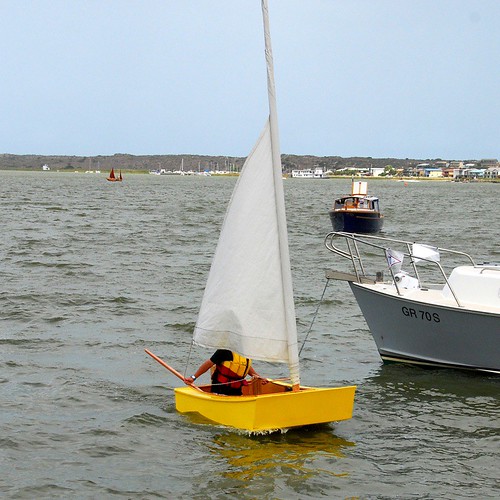 feeling of immanent peril – because the stability is so good. Just ease the sails a fraction and steer onto the right tack by sailing backwards – an easy and old dinghy and catamaran racing trick. In around 12 tacks I think I missed two of them while covering the best part of a kilometre dead upwind.
feeling of immanent peril – because the stability is so good. Just ease the sails a fraction and steer onto the right tack by sailing backwards – an easy and old dinghy and catamaran racing trick. In around 12 tacks I think I missed two of them while covering the best part of a kilometre dead upwind.
Even in the Oz Racer. – reduce sail the sneaky way – roll the leg of mutton sail around the mast and sheet to the transom.
When I went to head downwind again the wind had risen noticeable and I was a bit worried abour re-entering the corral at what would have been considerable speed. So I took the safe approach.
I went ashore where I was – about 2/3 of a mile upwind from the launch point, took off the boom and reduced the sail by about 2/3 by simply wrapping it around the mast – it was a dead run downwind to go back home and just needed a bit of rag to give me 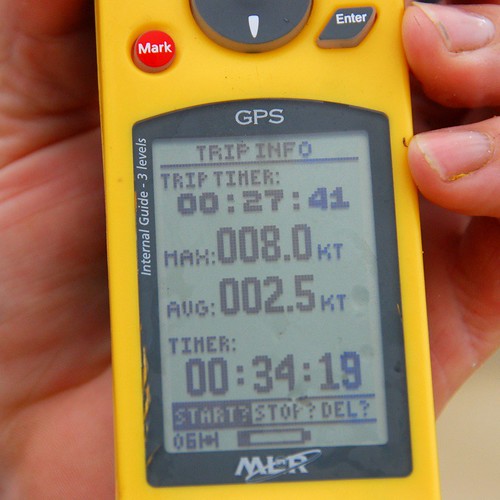 steerage. Down to the opening at a couple of knots, turn in and feet back on ground again.
steerage. Down to the opening at a couple of knots, turn in and feet back on ground again.
Pulled the GPS off. Remember the target was 6.2mph. It showed 8.0. Then someone pointed out that it was measuring in Knots.
This converts to a tiny shade over 9.2mph. It’s now time to get the record ratified!